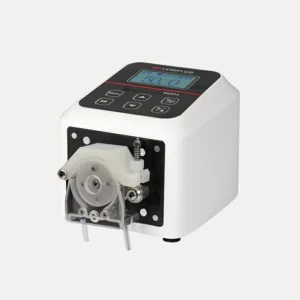Peristaltic pumps have emerged as a reliable and versatile solution for various fluid transfer applications, including diagnostic reagent dispensing. In this news article, we will explore the latest advancements in peristaltic pump technology, focusing on diagnostic reagent dispensing peristaltic pumps, peristaltic pump speed control, and their role in fluid transfer processes.

Design Characteristics of Diagnostic Reagent Dispensing Peristaltic Pump
Diagnostic reagent dispensing peristaltic pumps are specifically designed for the precise and controlled delivery of reagents in medical diagnostics and laboratory settings. These pumps offer several key features and advantages:
- Accuracy and Precision: Diagnostic reagent dispensing peristaltic pumps provide high accuracy and precision, ensuring consistent and reliable dispensing of reagents. This is crucial for maintaining the integrity of diagnostic tests and achieving accurate results.
- Programmable Dispensing Parameters: These pumps allow users to program dispensing parameters such as volume, flow rate, and dispensing intervals, enabling automated and repeatable processes.
- Compatibility with Various Reagent Viscosities: Diagnostic reagent dispensing peristaltic pumps can handle a wide range of reagent viscosities, from low-viscosity solutions to highly viscous fluids, ensuring versatility in different diagnostic applications.
- Contamination-Free Dispensing: The closed system design of peristaltic pumps prevents direct contact between the reagent and the pump components, minimizing the risk of contamination and ensuring the purity of the dispensed reagents.
- Easy Maintenance and Tubing Replacement: Peristaltic pumps are known for their easy maintenance and tubing replacement, reducing downtime and enhancing operational efficiency.
These pumps play a crucial role in diagnostic laboratories, enabling accurate and efficient dispensing of reagents for tests such as immunoassays, clinical chemistry, and molecular diagnostics.
Peristaltic Pump Speed Control
Peristaltic pump speed control is a vital aspect of fluid transfer processes, allowing for precise control over flow rates and dispensing volumes. Recent advancements in peristaltic pump technology have focused on enhancing speed control capabilities. Key developments include:
- Variable Speed Control: Modern peristaltic pumps offer variable speed control, allowing users to adjust the pump’s rotational speed to achieve the desired flow rate. This flexibility is essential for accommodating different fluid viscosities and application requirements.
- Stepper Motor Technology: Many peristaltic pumps now incorporate stepper motor technology, enabling precise speed control and accurate fluid delivery. Stepper motors provide excellent control resolution, ensuring consistent and reliable performance.
- Advanced Control Interfaces: Peristaltic pumps are equipped with user-friendly control interfaces, allowing operators to set and monitor pump speed parameters easily. Some pumps even offer programmable speed profiles for automated processes.
- Feedback Mechanisms: Advanced peristaltic pumps may include feedback mechanisms, such as flow sensors or load cells, to provide real-time monitoring and feedback on fluid flow rates. This enhances accuracy and enables closed-loop control systems.
These advancements in peristaltic pump speed control contribute to improved fluid transfer processes, ensuring precise dosing, reduced waste, and enhanced productivity in various industries.
Advantages of Fluid Transfer Peristaltic Pump
Fluid transfer peristaltic pumps are widely used in industries where gentle and contamination-free fluid handling is crucial. Key features and advantages of these pumps include:
- Gentle Fluid Handling: Peristaltic pumps utilize a squeezing action on flexible tubing, providing gentle fluid handling. This makes them suitable for transferring delicate fluids, such as biological samples, pharmaceutical formulations, and sensitive chemicals.
- Contamination-Free Transfer: The closed system design of peristaltic pumps ensures that the fluid only comes into contact with the tubing, minimizing the risk of contamination and preserving the integrity of the transferred fluid.
- Versatility and Compatibility: Fluid transfer peristaltic pumps can handle a wide range of fluids, including corrosive chemicals, viscous liquids, and abrasive slurries. The availability of different tubing materials allows compatibility with various fluid types.
- Easy Tubing Replacement and Maintenance: Peristaltic pumps are known for their easy tubing replacement, reducing downtime and simplifying maintenance. This feature is particularly beneficial in industries where frequent tubing changes are required.
Fluid transfer peristaltic pumps find applications in industries such as pharmaceutical manufacturing, biotechnology, food and beverage processing, and wastewater treatment, where precise and contamination-free fluid transfer is essential.
Advancements in peristaltic pump technology have revolutionized fluid transfer processes, particularly in the fields of diagnostic reagent dispensing and general fluid transfer applications. Diagnostic reagent dispensing peristaltic pumps offer accuracy, precision, and compatibility with various reagent viscosities, ensuring reliable diagnostic test results. Peristaltic pump speed control advancements enable precise flow rate control and enhanced automation capabilities. Fluid transfer peristaltic pumps provide gentle and contamination-free fluid handling, making them indispensable in industries where maintaining the integrity of transferred fluids is critical. With ongoing advancements, peristaltic pumps continue to play a vital role in improving efficiency, accuracy, and productivity in various sectors.